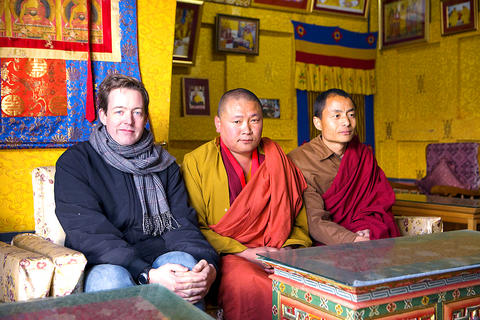Some 110 Bhutanese objects and 330 films of the country's ritual dances never before seen in the West will go on display in The Dragon's Gift: The Sacred Arts of Bhutan at the Honolulu Academy of Arts.
The curatorial first got started in the fall of 1997, when Ephraim Jose, a conservator of Asian and Himalayan art, had a 24-hour layover in Paro, Bhutan, on his way home from a vacation.
Jose's guide arranged for a tour of the National Museum. When the museum's director learned that Jose was a master conservator, he asked him to restore some thangkas - traditional painted or embroidered scroll paintings - in the collection. Jose promised he would do so someday.

PHOTO: NY TIMES NEWS SERVICE
Returning to San Francisco, he approached Terese Tse Bartholomew, curator of Himalayan art at the Asian Art Museum in San Francisco, about organizing an exhibition of Bhutanese art. She tried for several years but had no luck securing assent from the Bhutanese government.
Finally, in 2003, she took the idea to Little, who was the curator of Asian art at the Art Institute of Chicago and was about to decamp to a new post as director of the Honolulu Academy of Arts. Little was intrigued. There had never been a comprehensive art-historical exhibition of Bhutanese art, and there was so little published on the subject that it was hard to imagine what such a show would look like.
Little rewrote the exhibition proposal and sent it to Bhutan's government, suggesting that it include not just works of art but also documentation of the ritual dance called cham. Original fieldwork would be performed by art curators and filmmakers and financed through grants to the Honolulu Academy. He received approval from the government in 2004.
Around that time, Little received a phone call from John Johnston, a former art intern he had worked with who now had a master's degree in art history and specialized in Chinese Buddhist art. Better yet, Johnston was temporarily out of a job.
Little realized he had an ideal candidate. Johnston was a practicing Buddhist and was willing to move to Bhutan for a couple of years and learn Dzongkha.
From March 2005 to March 2007, Johnston lived in Bhutan full time, learning how to handle sacred images and developing a strategy for "how to conduct ourselves," he said. He, Bartholomew, Little and a Bhutanese expert in Buddhist iconography, Reda Sobky, reviewed snapshots of thousands of artworks at the government's Department of Culture before heading out into the field to locate them.
One major find was Seula Gonpa, a monastery in western Bhutan, which is now a school for young monks and seven hours by foot from the nearest road. There, Johnston was shown 75 to 100 thangkas, each more beautiful than the last. Yet many of the works were in terrible condition after years of being venerated in front of butter lamps emitting thick acrid smoke and stacked in infested bins.
Johnston returned to the capital with photographs of his discoveries. Before making selections for the show, curators assembled a group of Bhutanese monks, lamas and scholars to discuss the iconography. "Books could not help us because nobody had written about Bhutanese iconography," Johnston said.
While Johnston was doing his fieldwork, Little enlisted Joseph Houseal, a choreographer and dance preservationist. Houseal and Gerard Houghton, a cameraman, made two early trips to Bhutan to witness the cham dances without shooting any film. Then they developed some noninvasive production techniques that would allow them "to make a clear historical record of the structure of the dance and the shape of the choreography," Houseal said.

April 28 to May 4 During the Japanese colonial era, a city’s “first” high school typically served Japanese students, while Taiwanese attended the “second” high school. Only in Taichung was this reversed. That’s because when Taichung First High School opened its doors on May 1, 1915 to serve Taiwanese students who were previously barred from secondary education, it was the only high school in town. Former principal Hideo Azukisawa threatened to quit when the government in 1922 attempted to transfer the “first” designation to a new local high school for Japanese students, leading to this unusual situation. Prior to the Taichung First

The Ministry of Education last month proposed a nationwide ban on mobile devices in schools, aiming to curb concerns over student phone addiction. Under the revised regulation, which will take effect in August, teachers and schools will be required to collect mobile devices — including phones, laptops and wearables devices — for safekeeping during school hours, unless they are being used for educational purposes. For Chang Fong-ching (張鳳琴), the ban will have a positive impact. “It’s a good move,” says the professor in the department of

On April 17, Chinese Nationalist Party (KMT) Chairman Eric Chu (朱立倫) launched a bold campaign to revive and revitalize the KMT base by calling for an impromptu rally at the Taipei prosecutor’s offices to protest recent arrests of KMT recall campaigners over allegations of forgery and fraud involving signatures of dead voters. The protest had no time to apply for permits and was illegal, but that played into the sense of opposition grievance at alleged weaponization of the judiciary by the Democratic Progressive Party (DPP) to “annihilate” the opposition parties. Blamed for faltering recall campaigns and faced with a KMT chair

Article 2 of the Additional Articles of the Constitution of the Republic of China (中華民國憲法增修條文) stipulates that upon a vote of no confidence in the premier, the president can dissolve the legislature within 10 days. If the legislature is dissolved, a new legislative election must be held within 60 days, and the legislators’ terms will then be reckoned from that election. Two weeks ago Taipei Mayor Chiang Wan-an (蔣萬安) of the Chinese Nationalist Party (KMT) proposed that the legislature hold a vote of no confidence in the premier and dare the president to dissolve the legislature. The legislature is currently controlled